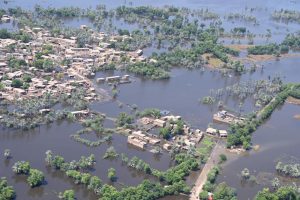Canal colonies in floodplains brace for disaster as NDMA flags extends rain spell; 64 dead from earlier downpours

ISLAMABAD, July 4 – The National Disaster Management Authority (NDMA) has issued a nationwide alert forecasting heavy rainfall, thunderstorms, and flash floods across Pakistan from July 6 to 10, 2025, warning of severe impacts across canal-irrigated regions of the country.
The advisory spans all provinces — including Punjab, Sindh, Khyber Pakhtunkhwa (KP), Balochistan, Gilgit-Baltistan, and Azad Jammu & Kashmir — with high-risk districts placed on alert for urban and rural flooding.
Key cities include Lahore, Multan, Faisalabad, Bahawalpur, Hyderabad, Sukkur — all historically surrounded by canal colonies developed during British colonial rule as a revenue-driven irrigation scheme. Built on floodplains, these areas have grown into major urban hubs but remain ecologically vulnerable.
“Settling people in floodplains was a political and engineering choice, not a hydrological necessity,” said Dr. Hassan Abbas, a leading hydrologist and advocate for floodplain rehabilitation. “What we now face is the cost of ignoring the river’s natural rights and rhythms.”
Decades of unregulated urban expansion, choked drainage, and aging infrastructure have made these settlements increasingly prone to floods. NDMA reports 64 deaths and 117 injuries from rainfall in late June, mostly in Punjab and KP. Local authorities have been directed to clear drains, prepare emergency services, and issue real-time alerts via the Pak NDMA Disaster Alert App.
The looming crisis rekindles memories of the 2022 super flood, one of the worst in Pakistan’s history. Triggered by record monsoon rains and glacial melt, the disaster affected 33 million people, killed over 1,700, destroyed 2 million homes, and caused over $30 billion in economic losses. Canal-irrigated regions were among the worst hit due to encroached floodplains, collapsed drainage, and lack of zoning.
Despite that, Pakistan’s current climate finance plans — under the Loss and Damage and Adaptation Fund frameworks — remain infrastructure-centric, focusing on canal linings, embankments, and additional storage. Experts like Dr. Abbas warn such “hardening” strategies could worsen risks unless paired with ecological restoration, floodplain governance, and groundwater recharge.
The flood threat is further aggravated by untreated wastewater and solid waste, which block drainage and contaminate floodwaters. UNDP data shows over 90% of urban wastewater in Pakistan is released untreated, increasing the risk of disease outbreaks during floods.
As extreme weather grows more frequent, Pakistan’s irrigated heartland is facing not only the pressures of climate volatility but the long-term consequences of flawed development models and delayed reform.
 Radio News Network Radio News Network
Radio News Network Radio News Network
